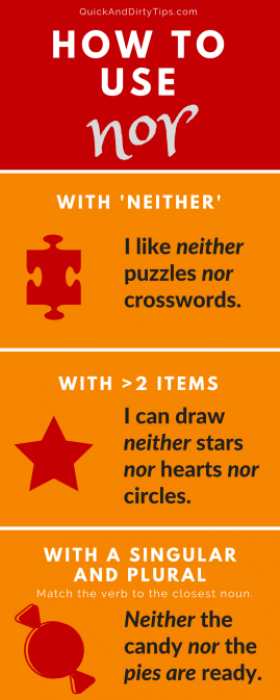Today we’re going to get a bit negative by looking at the various times you can use the word “nor.”
‘Nor’ with ‘Neither’
- Everybody knows that “neither” and “nor” are bosom buddies. They require balance. A “nor” usually follows a “neither” when they’re used in the same sentence (1). For example, you might say, “I like neither hot dogs nor mustard.” You may also use “nor” if you’re talking about more than two items, but you must repeat “nor” after each element (2). So if you want to add ketchup to your list of dislikes, you have to say, “I like neither hot dogs nor mustard nor ketchup.” It would be incorrect to use an “or” anywhere in that sentence—or to leave out either case of “nor.”
- “Neither” can appear at the beginning of a sentence as well as the middle. For example, “Neither the man nor the woman is a good surfer” is nice and balanced.
- The issue gets a little complicated when the two items in the “neither-nor” part of the sentence are a mix of singular and plural. If you changed the sentence to discuss the surfing skills of two men and one woman (one plural, one singular), what would you do? Writer Patricia O’Connor (3) calls this “a two-headed creature,” but luckily for us, it’s not as complicated as it seems. Simply take the noun closest to the verb and ensure they agree. So “Neither the men nor the woman is a good surfer” is correct, as is “Neither the woman nor the men are good surfers.” Note how we use the plural word “surfers” at the end there to keep everything in agreement.
- “Nor” doesn’t necessarily have to appear in a sentence with the word “neither.” “Nor” can start a sentence. For example, if you’ve just mentioned that you don’t usually wake up at 6 a.m. and you want to continue being negative, you can start another sentence with “nor”: “Nor do I like to wake up at 5 a.m.” Another option is to combine the two negative ideas into one sentence and then start the second part with “nor”: “I don’t usually wake up at 6 a.m., nor do I like to wake up at 5 a.m.”
When to Use ‘Or’ Instead of ‘Nor’
‘Neither’ and ‘nor’ are bosom buddies. They require balance.
In all our examples so far, we’ve used “nor” to indicate a negative state that continues after something else negative happens. However, when the second negative item is a noun, adjective, or adverb phrase (4), you should use “or” to continue the negative thought because according to Bryan Garner “the initial negative carries through to all the enumerated elements” (5). For example, when you use the word “not,” the structure “not A or B” is correct. You’d have to say, “He is not interested in math or science”; “He is not interested in math nor science” won’t work. Likewise, “She didn’t speak slowly or clearly” has a better ring to it than “She didn’t speak slowly nor clearly.”
When to Use Either ‘Nor’ or ‘Or’
If, on the other hand, the second part of the negative is a verb phrase—not a verb clause—then you can choose to use “nor” or “or” (6). Both of the following sentences will work: “Santa will not permit naughty behavior or even consider bringing presents.” “Santa will not permit naughty behavior nor even consider bringing presents.” You as the writer get to decide which one sounds better. If you’re unsure which word to use, or if you want to avoid the problem, you can try saying, “and no” for the second part of the negative (7): “I have no time and no money.” The phrase “and not” will also work: “Santa will not permit naughty behavior and will not even consider bringing presents.”
Warning
You do need to be careful about keeping your “neither” and “nor” parallel (8). For example, it would be wrong to write, “He will study neither his lesson nor do his chores.” The part that follows “neither” is a noun (“his lessons”), and the part that follows “nor” is a verb phrase (“do his chores”). You want those two parts to match. You can fix it by moving the “neither” so it comes before the word “study.” Then both parts are verb phrases: neither study his lessons, nor do his chores.
Summary
To summarize, “nor” often pairs up with “neither,” but not always. When it comes to other negative words, use “or” if the second part of the negative is a noun, adjective, or adverb phrase. If it’s a verb phrase, choose either “nor” or “or.” If you’re unsure which one to use, consider saying, “and no” or “and not” for the second part.
Web Bonus for Teachers
- Which sentence is correct?
A) I want neither persimmons nor kiwis.
B) I want neither persimmons or kiwis.
[Answer: A] - Which sentence is correct?
A) I don’t want persimmons nor kiwis.
B) I don’t want persimmons or kiwis.
[Answer: B] - Which sentence is correct?
A) Neither the trees nor the flower inspires me.
B) Neither the trees nor the flower inspire me.
[Answer:A] - Which sentence is correct?
A) Squiggly didn’t want to go to the library nor the principal’s office.
B) Squiggly didn’t want to go to the library or the principal’s office.
[Answer: B] - Which sentence has parallel structure?
A) Aardvark neither wondered about the outcome nor cared.
B) Aardvark wondered neither about the outcome nor cared.
[Answer: A]
References
- 1. American Heritage Guide to Contemporary Usage and Style. Boston: Houghton Mifflin Company, 2005, p. 320.
- 2. Walsh, B. “Lapsing Into a Comma: A Curmudgeon’s Guide to the Many Things That Can Go Wrong in Print—and How to Avoid Them.” Chicago: Contemporary Books, 2000, pp. 174-6.
- 3. O’Conner, P. “Woe Is I: The Grammarphobe’s Guide to Better English in Plain English.” New York: Riverhead Books, 1996, pp. 52-3.
- 4. American Heritage Guide to Contemporary Usage and Style. Boston: Houghton Mifflin Company, 2005, p. 320.
- 5. Garner, B. Garner’s Modern American Usage. Oxford: Oxford University Press, 2003, pp. 553-4.
- 6. American Heritage Guide to Contemporary Usage and Style. Boston: Houghton Mifflin Company, 2005, p. 320.
- 7. Garner, B. Garner’s Modern American Usage. Oxford: Oxford University Press, 2003, p. 554.
- 8. Walsh, B. “Lapsing Into a Comma: A Curmudgeon’s Guide to the Many Things That Can Go Wrong in Print—and How to Avoid Them.” Chicago: Contemporary Books, 2000, pp. 174-6.





